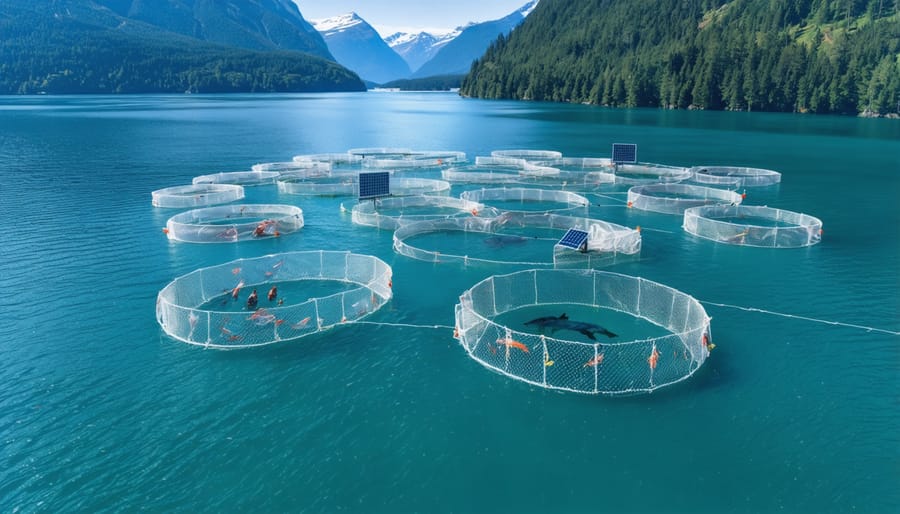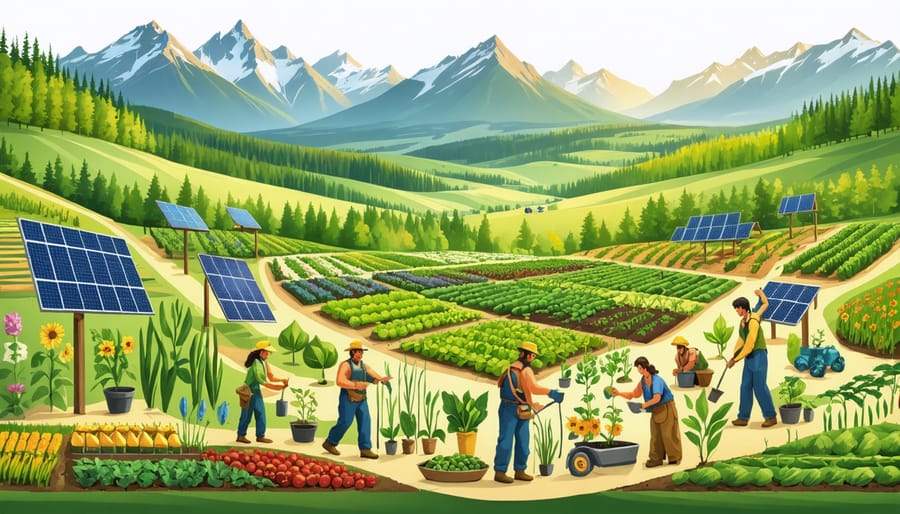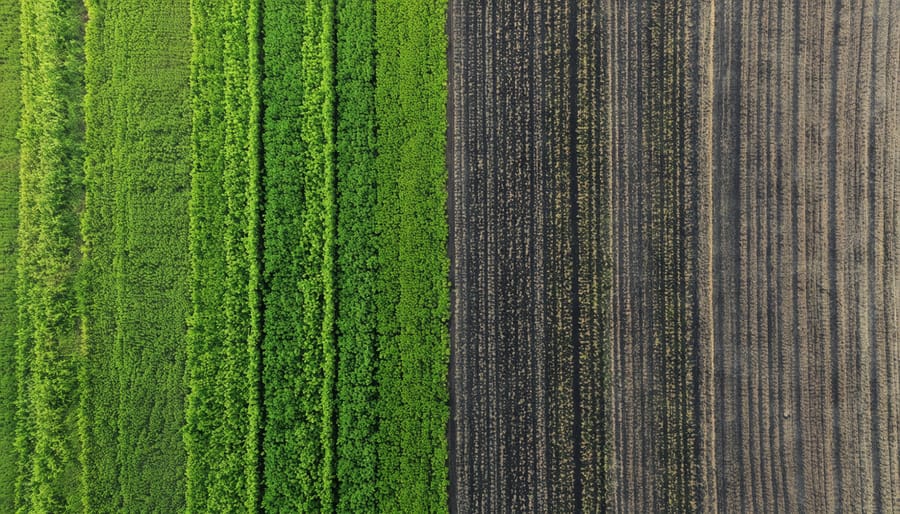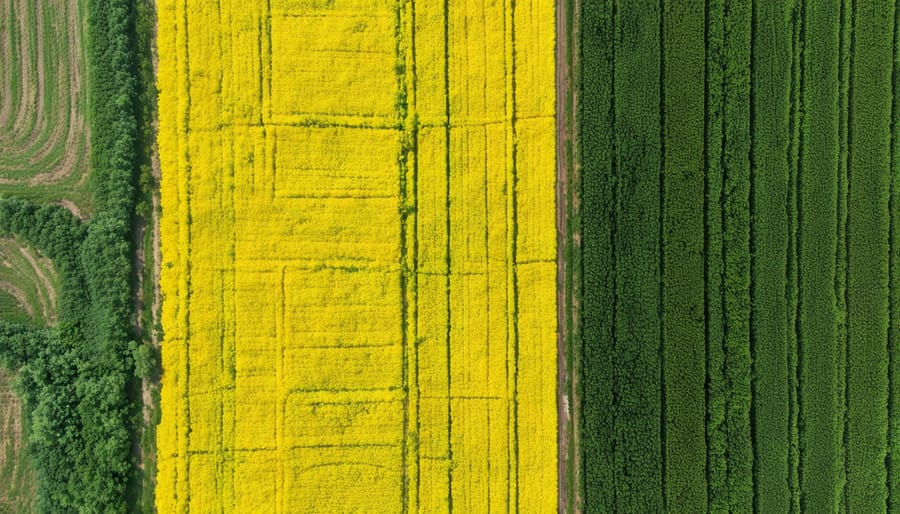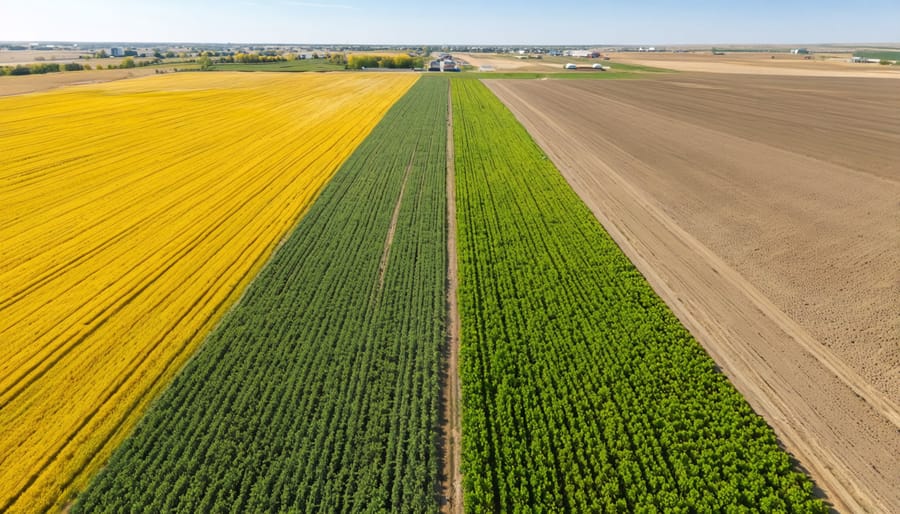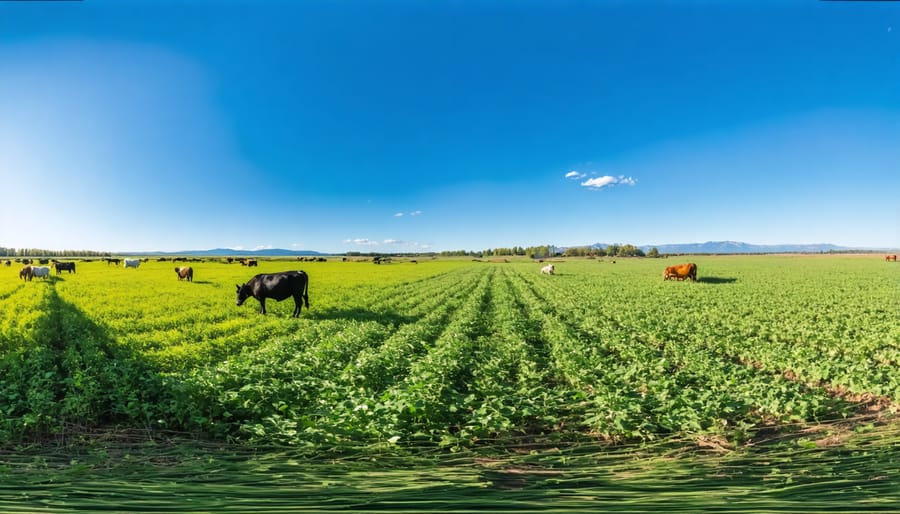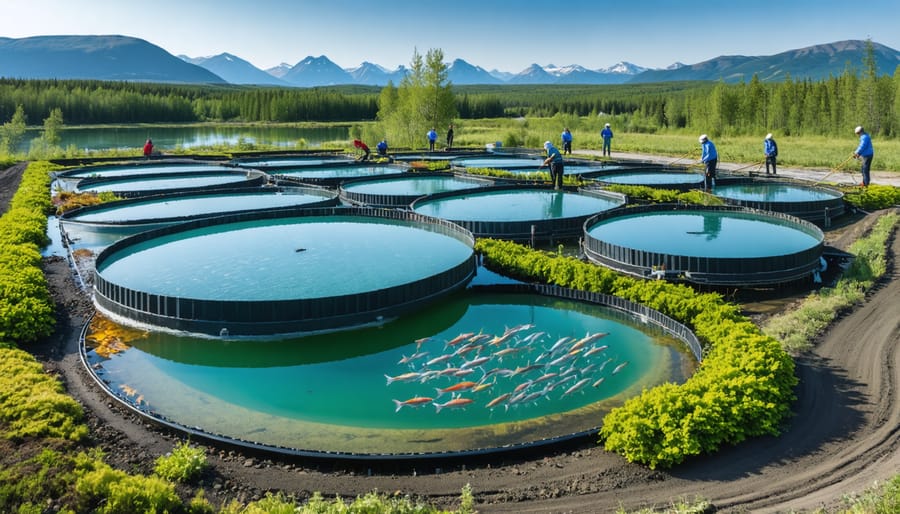Diversifying crop varieties and livestock breeds stands as a cornerstone of modern sustainable farming practices, particularly across Alberta’s varied agricultural landscape. When severe drought devastated wheat crops in Southern Alberta in 2021, farmers who had invested in drought-resistant heritage varieties maintained 60% of their expected yield, while those relying on single varieties faced near-total losses. This stark reality underscores how biodiversity acts as nature’s insurance policy against climate uncertainties, pest outbreaks, and market fluctuations.
From the Red Fife wheat revival in Saskatchewan to the success of mixed livestock operations in central Alberta, Canadian farmers are discovering that agricultural biodiversity delivers more than just risk management – it opens new market opportunities and strengthens local food systems. By maintaining a diverse array of food species, we’re not just preserving genetic resources; we’re building resilient food networks that can adapt to changing conditions while ensuring consistent food supply for future generations.
This practical approach to agricultural diversity has become increasingly crucial as Canadian farmers face unprecedented environmental challenges and market demands, making it essential to understand how biodiversity contributes to both immediate farm productivity and long-term food security.
The Power of Diversity in Your Fields

Beyond Monoculture: The Security Net of Multiple Crops
Relying on a single crop variety is like putting all your eggs in one basket – it’s a risky strategy that many Alberta farmers have learned to avoid. When disease strikes or extreme weather hits, monoculture systems can suffer devastating losses that ripple through entire communities. In contrast, implementing diverse cropping systems creates a natural insurance policy against these risks.
Take the example of the Davidson family farm near Red Deer, who integrated wheat, canola, and pulse crops into their rotation. When a late frost damaged their wheat in 2022, their other crops helped maintain their farm’s income stability. This approach to soil health through diversity also strengthens overall farm resilience.
Multiple crops provide varying harvest times, different root depths, and complementary nutrient needs. This diversity helps buffer against market fluctuations, spreads out workload throughout the season, and creates multiple income streams. Research from Agriculture Canada shows that farms implementing three or more crop varieties typically experience 30% less yield variation during challenging seasons compared to single-crop operations.
Alberta’s Success Story: Local Crop Diversity in Action
The Bergstrom family farm near Lethbridge showcases how crop diversity can thrive in Alberta’s climate. Over the past decade, they’ve expanded from traditional wheat and canola rotation to include pulses, ancient grains, and cover crops. Their 800-hectare operation now grows eight different crop species, resulting in a 30% increase in soil fertility and a 25% reduction in pest-related losses.
In the Peace River region, Sarah Chen’s innovative approach combines Indigenous farming wisdom with modern techniques. Her 400-hectare farm integrates traditional crops like saskatoon berries and hazelnuts with conventional grains. This diversity has helped her operation remain profitable even during challenging weather years, with crop insurance claims dropping by 40% since implementing these changes.
Near Red Deer, the Johnston Cooperative demonstrates the power of community-supported agriculture. Their network of five farms coordinates crop planning to ensure variety while sharing equipment and knowledge. This collaboration has enabled them to grow 15 different crop species across their combined 1,200 hectares, providing resilience against market fluctuations and environmental challenges.
These success stories prove that crop diversity isn’t just theoretically beneficial – it’s a practical solution for Alberta farmers seeking sustainable food security.
Genetic Diversity: Your Farm’s Insurance Policy
Heritage Varieties: Preserving Nature’s Toolbox
Heritage crop varieties are the living archives of our agricultural history, carrying genetic traits that have evolved over generations of farming in diverse conditions. Here in Alberta, many farmers are rediscovering the value of growing traditional varieties like Red Fife wheat and Early Rose potatoes, which often show remarkable resilience to local climate challenges.
These heritage varieties represent more than just nostalgia – they’re practical tools for modern agriculture. When Jim Anderson, a third-generation farmer near Lacombe, switched to growing heritage wheat varieties, he noticed they performed better during drought years compared to modern cultivars. “These old varieties might not yield as much in perfect conditions,” Jim explains, “but they’re consistent performers when weather patterns get unpredictable.”
The genetic diversity in heritage crops provides crucial resistance to pests and diseases. The Canadian Seed Bank in Saskatoon maintains over 110,000 seed samples, including traditional varieties that could hold the key to developing climate-resilient crops for future generations. These preserved genetics act as insurance against emerging agricultural challenges.
Local seed-saving networks across Alberta are working to maintain these varieties, organizing seed exchanges and documentation of growing techniques. By preserving heritage varieties, we’re not just maintaining biodiversity – we’re protecting time-tested solutions for food security challenges that Canadian farmers might face in the years ahead.
Building Resilience Through Seed Banking
Here in Alberta, our seed banks serve as vital guardians of agricultural biodiversity, protecting our food security for generations to come. The Crop Development Centre in Lacombe has been instrumental in preserving heritage grain varieties that have proven invaluable during challenging growing seasons.
Local farmers like Sarah Thompson from Red Deer County have established community seed libraries, where members can “borrow” seeds and return them after harvest. This practice has helped preserve over 200 locally adapted vegetable varieties, including cold-hardy tomatoes and drought-resistant bean varieties uniquely suited to our prairie climate.
The Seeds of Diversity program, active across Alberta, connects farmers who maintain diverse seed collections, creating a robust network of seed savers. These initiatives have proven particularly valuable during recent extreme weather events, where traditional varieties often showed better resilience than their commercial counterparts.
For new farmers looking to start seed saving, the Alberta Seed Network offers workshops and mentorship programs. They recommend beginning with easy-to-save crops like peas, beans, and tomatoes. Many participants report that beyond preservation, seed banking has created stronger community bonds and reduced input costs.
By maintaining diverse seed collections, Alberta farmers are not just preserving biodiversity – they’re building agricultural resilience from the ground up, ensuring our food systems can adapt to whatever challenges the future may bring.

Making Biodiversity Work for Your Bottom Line
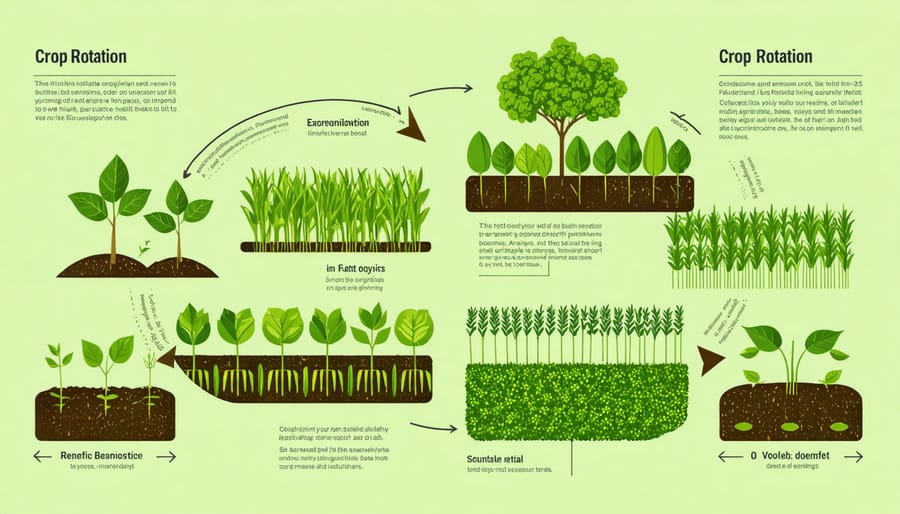
Smart Crop Rotation Systems
In Alberta’s diverse agricultural landscape, implementing smart crop rotation systems has become essential for maintaining both biodiversity and food security. By adopting innovative farming techniques, farmers are discovering that strategic rotation not only preserves soil health but also creates resilient food production systems.
A successful rotation strategy typically involves cycling through different crop families over 3-5 years. For example, many Alberta farmers start with wheat or barley, followed by legumes like field peas or fava beans, then canola or flax, and finally back to cereals. This sequence helps break pest cycles, improves soil structure, and maintains nutrient balance naturally.
Local success stories demonstrate the effectiveness of these systems. The Henderson family farm near Red Deer increased their yield by 15% after implementing a four-year rotation plan that included cover crops during shoulder seasons. They found that incorporating nitrogen-fixing crops reduced their fertilizer needs by approximately 30%.
For smaller operations, consider these practical rotation guidelines:
– Alternate between deep-rooted and shallow-rooted crops
– Include at least one legume crop in your rotation
– Plan for market demand while maintaining diversity
– Leave room for soil-building cover crops
The key to successful rotation lies in understanding your local growing conditions and soil type. Many Alberta farmers have found success by working with agricultural extension services to develop customized rotation plans that consider both environmental factors and market opportunities. This approach ensures both ecological sustainability and economic viability, contributing to long-term food security in our region.
Market Opportunities in Diverse Crops
Growing diverse crops opens up multiple revenue streams and helps farmers tap into various market opportunities throughout the year. Here in Alberta, we’ve seen farmers successfully diversify their operations beyond traditional wheat and canola to include specialty crops like quinoa, hemp, and various pulse crops.
Take Dave Thompson’s farm near Red Deer, for example. By introducing lentils and fava beans into his rotation, he’s not only improved his soil health but also accessed premium markets in both domestic and international trade. “Adding these crops helped stabilize our income,” Dave shares. “When wheat prices dipped last season, our pulse crops kept the operation profitable.”
The growing demand for plant-based proteins has created exciting opportunities for Canadian farmers. Local processors are actively seeking diverse crop supplies, often offering contracts with attractive premiums. The Alberta Pulse Growers report that market demand for yellow peas, chickpeas, and other legumes has increased by 30% over the past five years.
Heritage grain varieties are another promising market. Several Alberta bakeries now partner directly with farmers growing ancient grain varieties like Red Fife wheat and Purple Prairie barley, offering premium prices for these specialty crops. These partnerships often lead to stable, long-term relationships that benefit both parties.
Additionally, growing multiple crop species allows farmers to spread their harvest periods and marketing windows throughout the year, improving cash flow management. It also provides flexibility to respond to market fluctuations and changing consumer preferences, creating a more resilient business model for farm operations.
Climate Change Ready: Biodiversity as Your Shield
Weather-Proof Your Farm Through Diversity
Building a weather-resilient farm starts with embracing diversity in your crop selection and farming practices. Here in Alberta, we’ve seen how unpredictable weather patterns can impact yields, but farmers who maintain diverse operations consistently show better resilience to these challenges.
Consider the experience of Sarah Thompson, a third-generation farmer near Lethbridge, who rotates between six different crop varieties. “When we had that severe drought in 2021, our pulse crops helped sustain us while the wheat struggled,” she shares. This approach of not putting all your eggs in one basket has proven effective across the province.
Key strategies for building weather resilience through biodiversity include:
– Interplanting companion crops that support each other during stress periods
– Maintaining heritage seed varieties that are naturally adapted to local conditions
– Including drought-resistant species in your rotation
– Establishing windbreaks with native species to protect sensitive crops
– Incorporating cover crops to improve soil health and moisture retention
The Alberta Climate-Smart Agriculture Program has documented that farms with diverse crop systems typically see 20-30% better yield stability during extreme weather events compared to monoculture operations.
Remember to start small when diversifying your farm. Try introducing one or two new varieties each season, and pay attention to how different combinations work together. Local agricultural extension offices can provide guidance on which diverse crops are best suited for your specific region and soil type.
Future-Proofing Alberta’s Food Supply
Alberta’s agricultural landscape is evolving, and maintaining crop diversity is becoming increasingly crucial for long-term food security. By cultivating various crop species and livestock breeds, farmers create resilient food systems that can better withstand climate fluctuations, pest pressures, and market changes.
Local seed banks and gene preservation programs are playing a vital role in safeguarding Alberta’s agricultural future. The University of Alberta’s seed vault, for instance, maintains over 2,500 distinct crop varieties adapted to our unique growing conditions. These resources support various food security initiatives across the province.
Many Alberta farmers are already embracing diversity through innovative crop rotation systems. For example, the Three Hills region has seen success with eight-year rotation cycles that include traditional grains, pulses, and cover crops. This approach not only protects soil health but also provides multiple income streams throughout the growing season.
Indigenous agricultural knowledge continues to inform biodiversity practices, with traditional varieties like Saskatoon berries and heritage grains gaining renewed interest among producers. These crops often demonstrate superior drought tolerance and pest resistance, making them valuable additions to modern farming operations.
Looking ahead, maintaining agricultural biodiversity will be essential for adapting to changing climate patterns and ensuring stable food production for future generations. By preserving and expanding our crop diversity today, we’re investing in Alberta’s food security tomorrow.
As we’ve explored throughout this article, enhancing biodiversity in our food systems is crucial for Alberta’s agricultural future. Taking action starts right on your farm, with simple yet effective steps like introducing cover crops, implementing crop rotation cycles, and maintaining field margins for beneficial insects and pollinators.
Consider starting small by diversifying just one field or partnering with neighbouring farms to share resources and knowledge. Local agricultural extension offices and farming cooperatives can provide valuable support and guidance as you transition to more diverse farming practices.
Remember that successful biodiversity strategies often combine traditional farming wisdom with modern agricultural innovations. Whether it’s incorporating heritage grain varieties into your rotation or establishing pollinator-friendly corridors, every step counts toward building a more resilient food system.
Connect with local seed banks and agricultural research stations to access diverse crop varieties suited to our unique Alberta growing conditions. Take advantage of workshops and field days to learn from other farmers who have successfully implemented biodiversity practices.
By working together as a farming community, we can create a more secure and sustainable food future. Your efforts to increase biodiversity on your farm contribute to both local food security and the broader resilience of Canadian agriculture. Start planning your biodiversity strategy today, knowing that even small changes can lead to significant improvements in farm productivity and ecosystem health.




